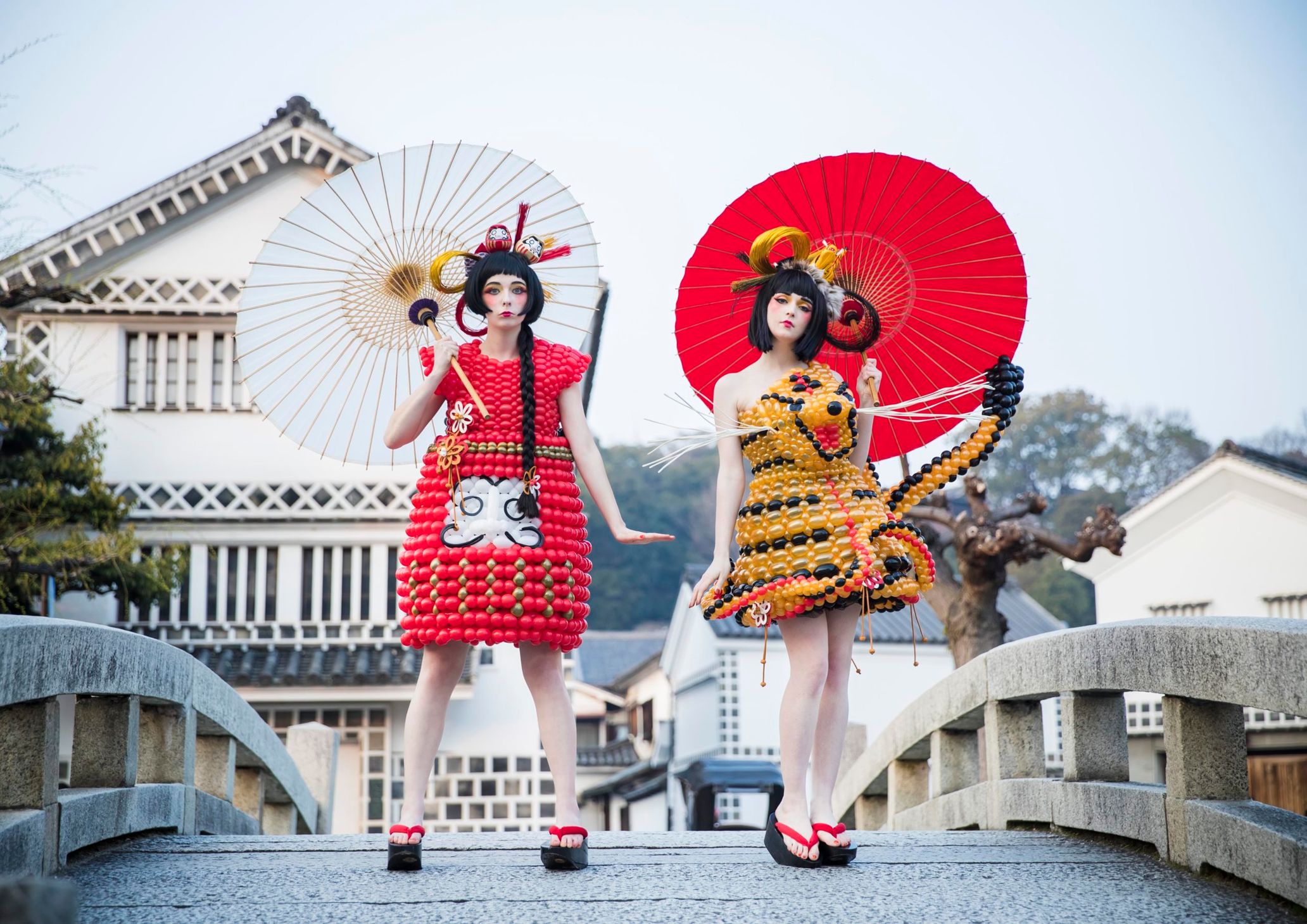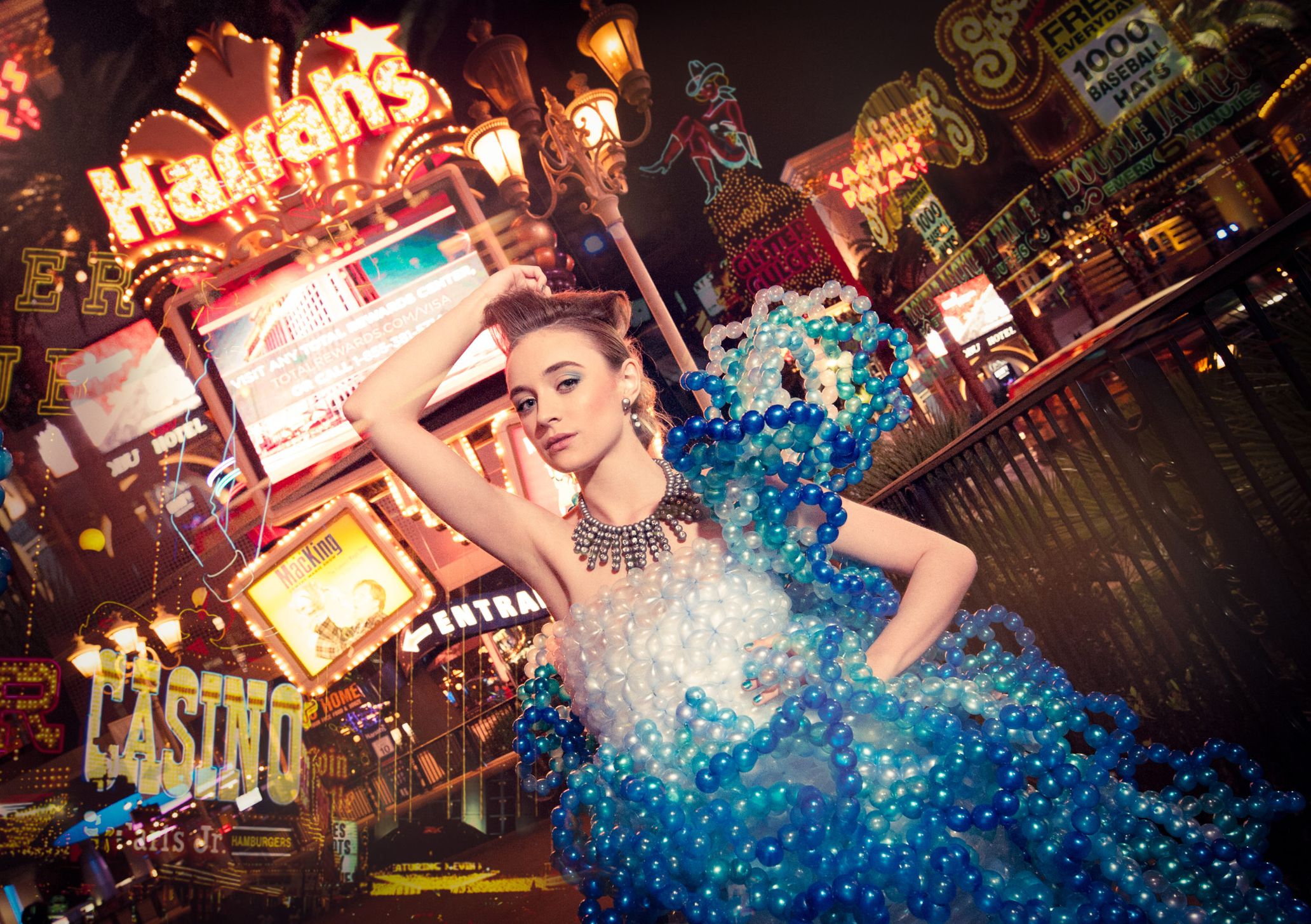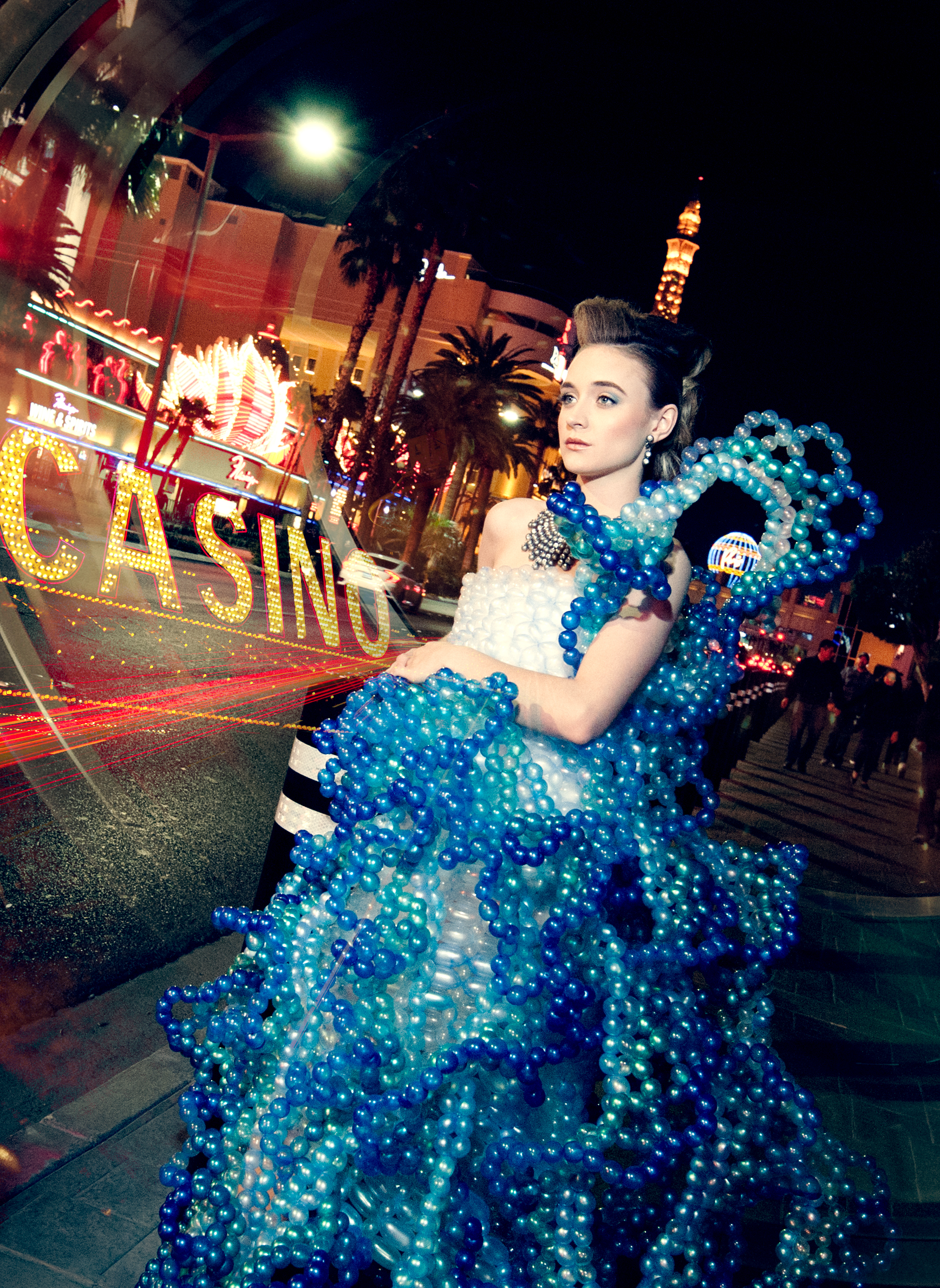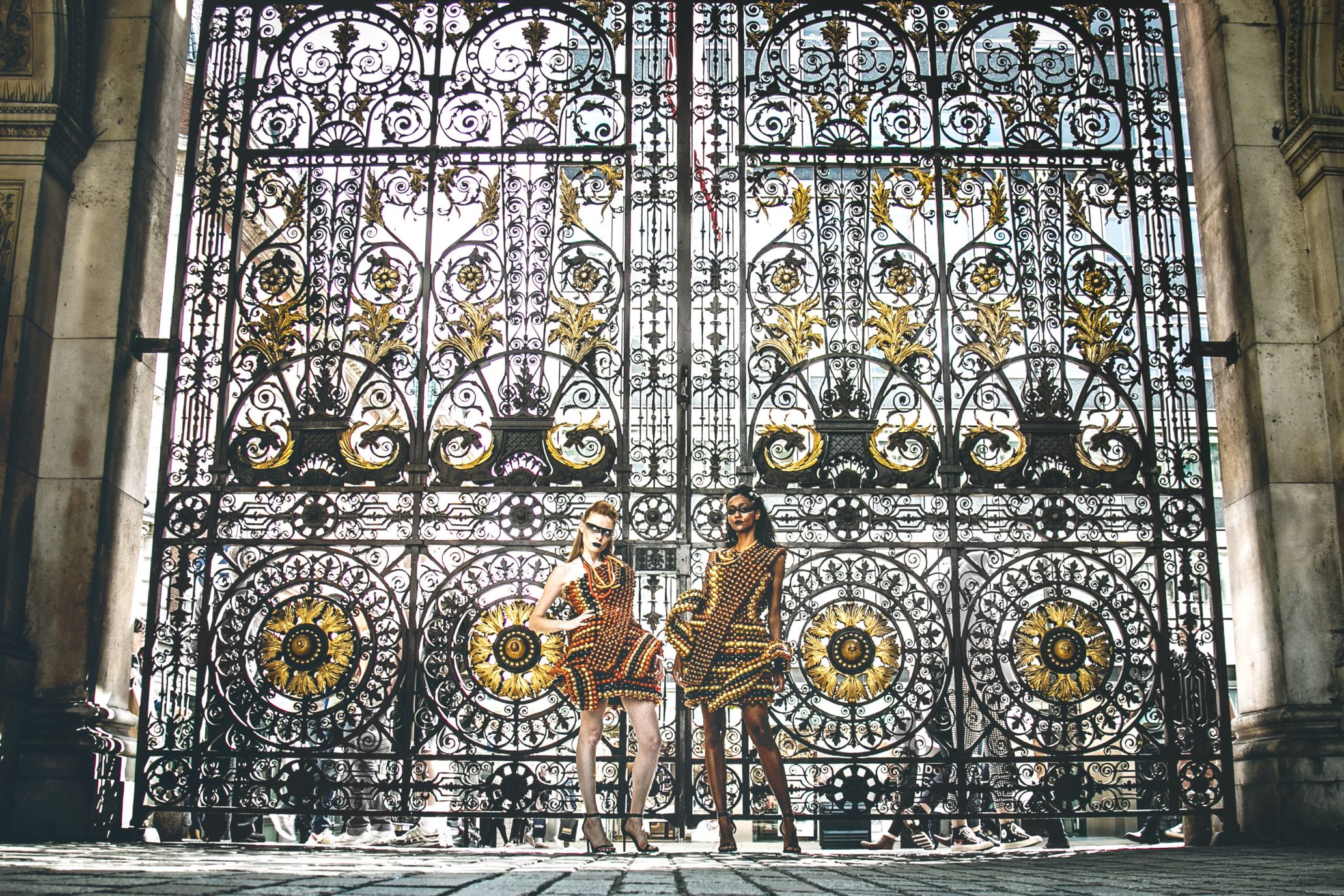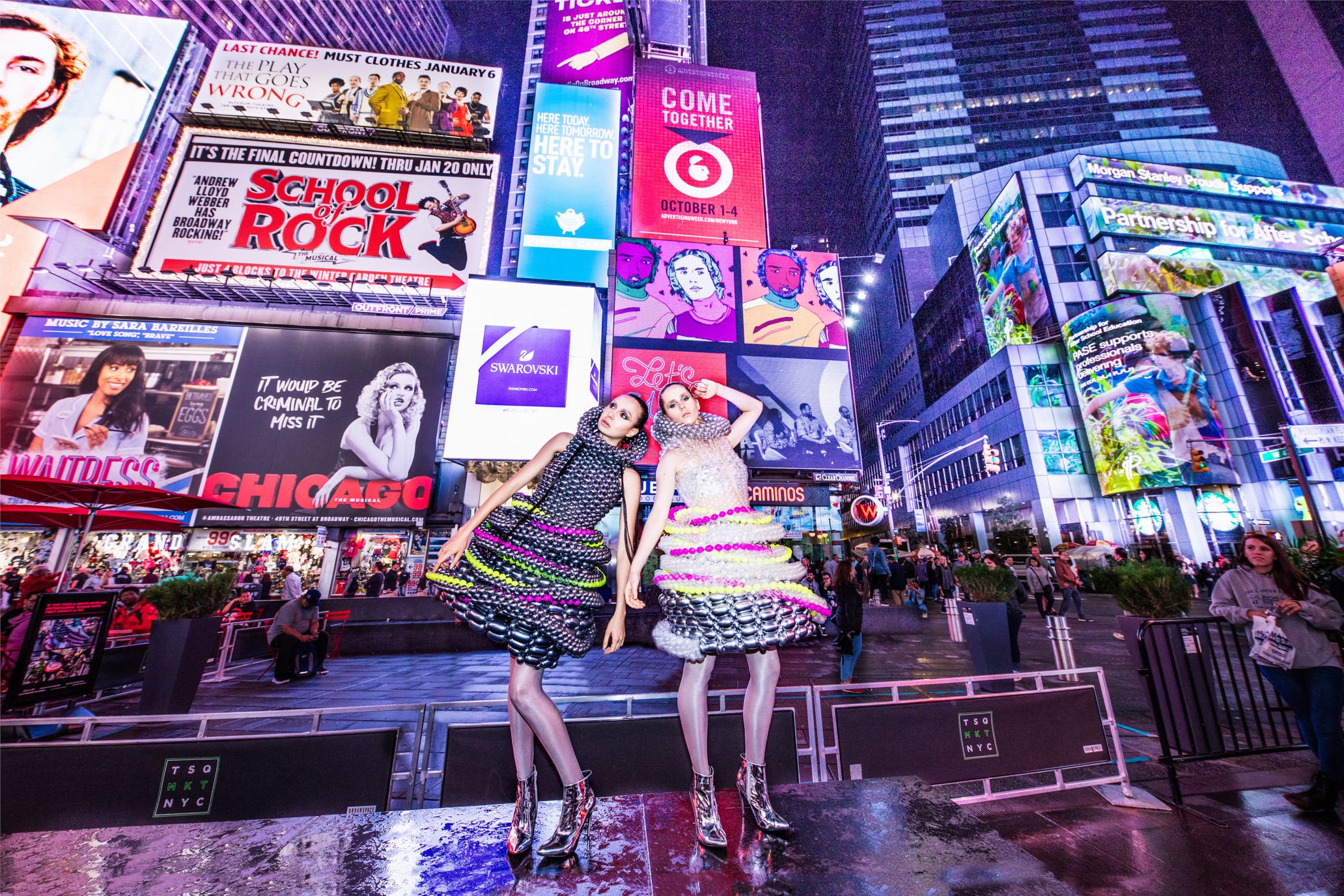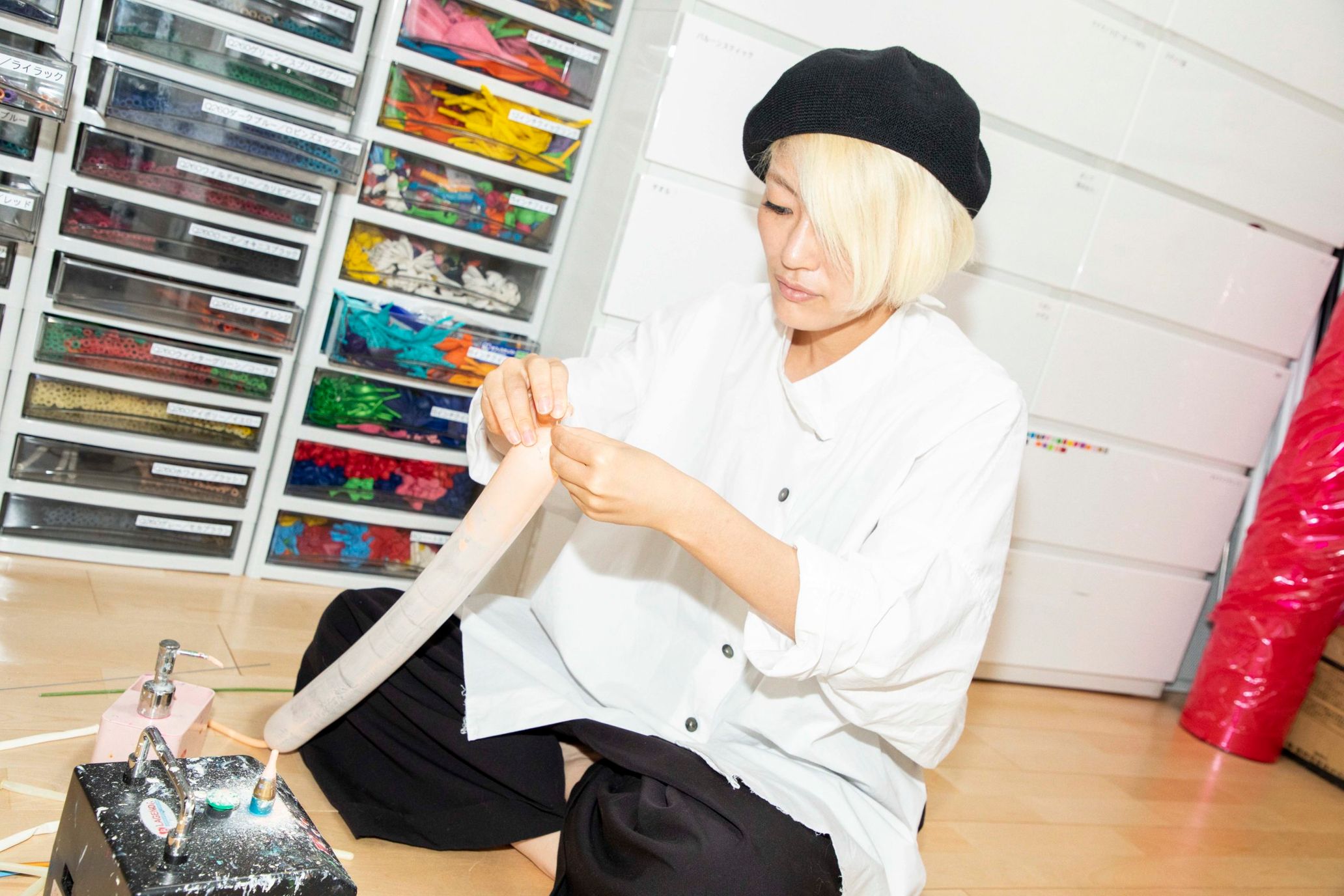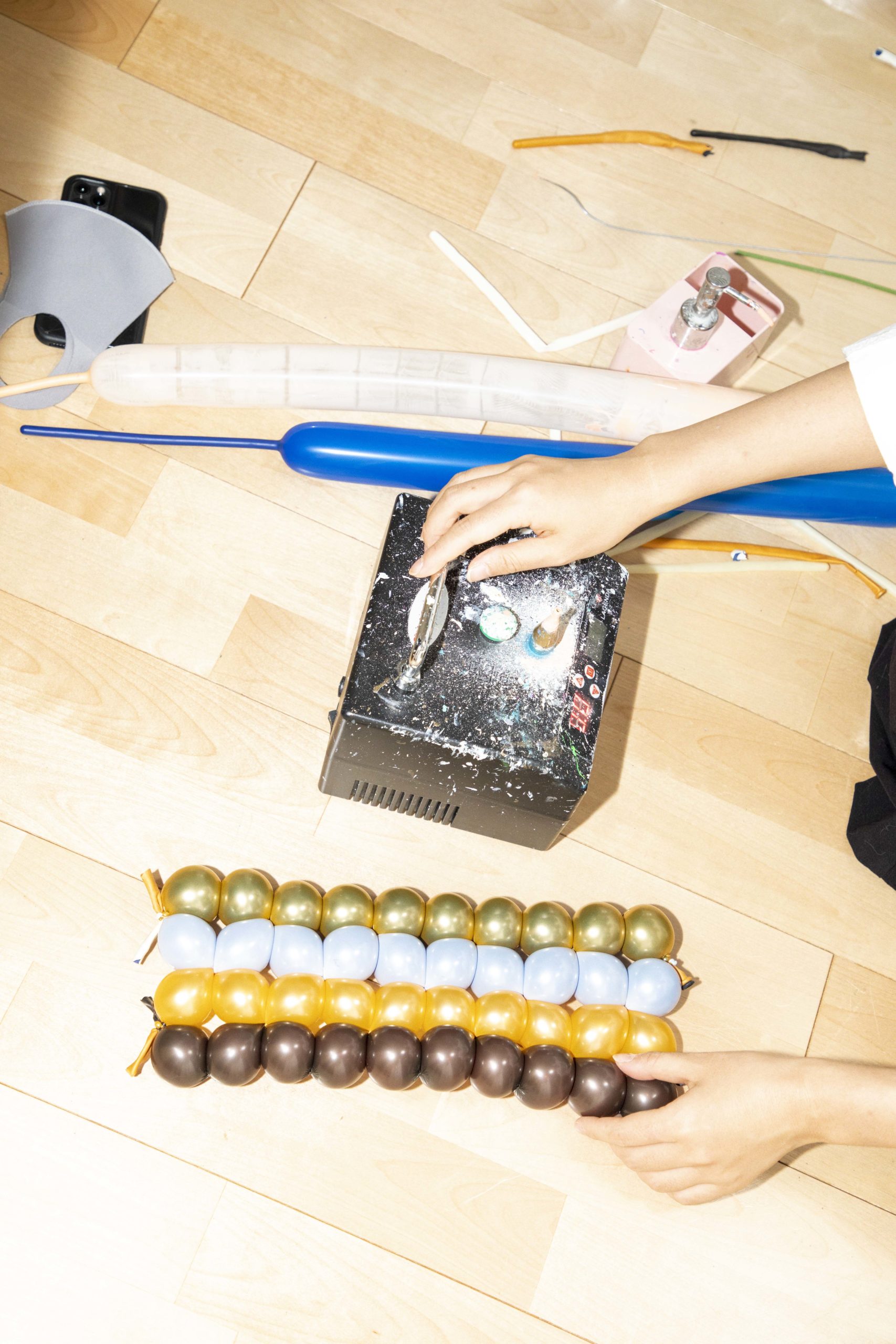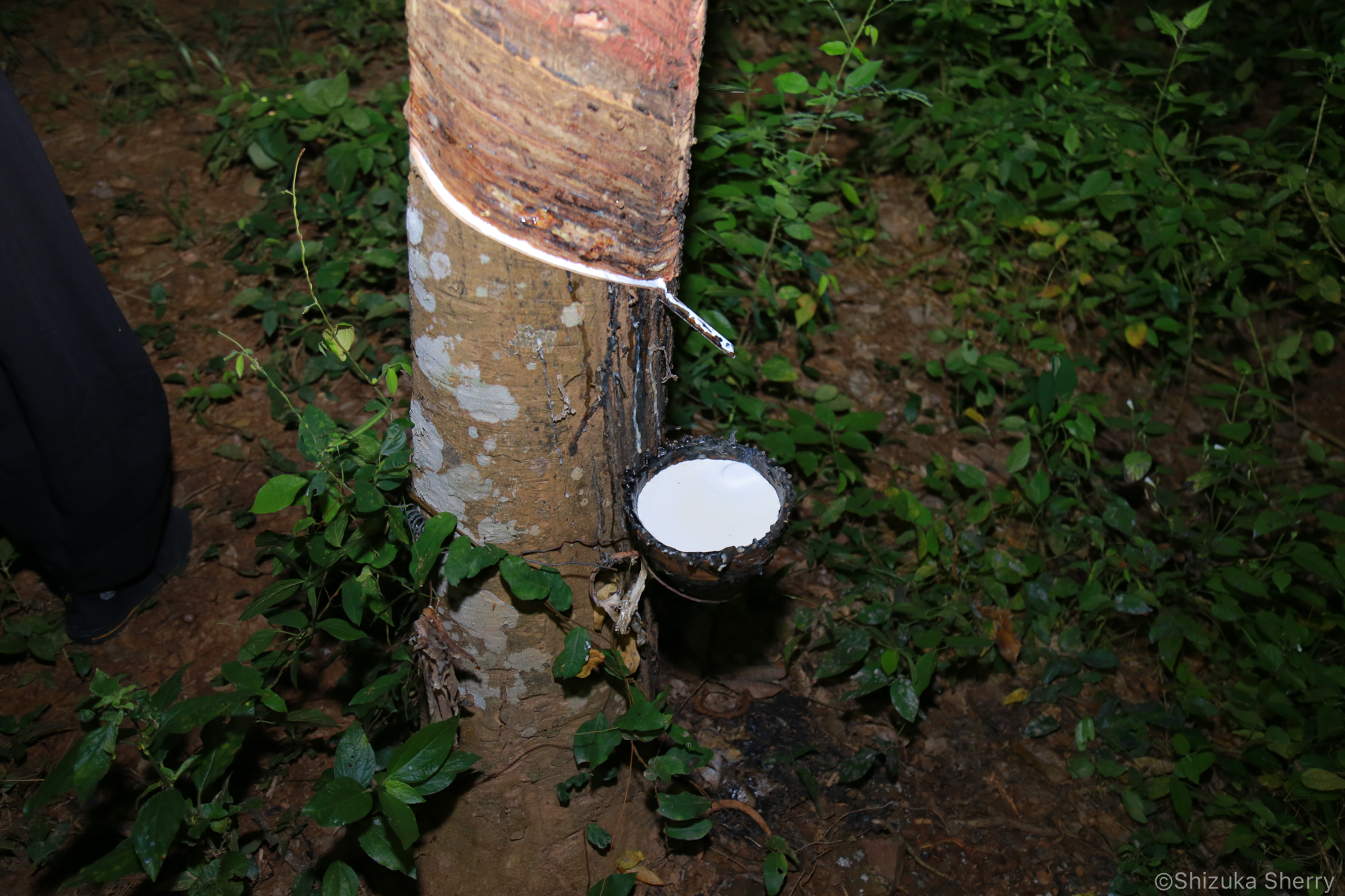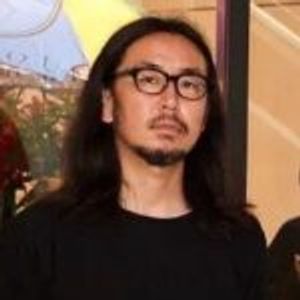In 2019, one Japanese balloon artist garnered attention from overseas at Vancouver Fashion Week, which boasts the second largest size for a fashion week in North America. It was Emi Jingu, who won the US Balloon Art Dress Competition in 2018. Her balloon pieces featuring pop coloring span from dresses to shoes and accessories. Emi Jingu has continued to present a number of creative balloon dresses with a fixation on color. But what sentiments does she bring to her balloon art?
Vancouver Fashion Week 2019
——First off, could you tell us what prompted you to start making balloon art?
Emi Jingu (referred to as Jingu below): There was a time when I was a performer in mainly children’s theater, where I traveled around to elementary schools all over Japan. At one point I was looking for a way to put my time on the weekends to good use, and saw a listing recruiting staff to hand out balloons at home exhibition rooms in a part-time job listings magazine. So I took the job half out of curiosity, and it turned out to be a lot more fun than I had imagined. With a play you provide the audience with a deeply moving experience over about two hours, but when I would hand out balloons the children’s faces would light up instantly as if by magic. It was seeing their faces like that that motivated me.
——Perhaps you were just naturally gifted at it, but this is a field with high hurdles against breaking into it without experience.
Jingu: That’s right. Maybe I just never thought about it too deeply (laughs). But seeing the smiling, carefree faces of the children as I was handing out balloons left a really strong impression on me. I stopped working as a performer at the end of that fiscal year and immediately became a freelance balloon artist. This was in 2012. My initial debut was as a balloon performer.
——You made your debut at the Dai Don Den street performer festival in Sapporo, correct? What sort of event is that?
Jingu: With balloon artists there are areas of specialty like decorating, gifts, entertainment, and so on, but maybe it was because of my initial experience in theater that made me more performance-oriented. Dai Don Den isn’t around anymore, but it was a famous event with its own history among balloon-related events. Noteworthy balloon artists used to take part.
——Was it the street performers and performances there that motivated you to move more in the direction of pursuing fashion, like with your balloon dresses?
Jingu: I’m not exactly sure, but fashion culture has been rooted in the balloon industry since the beginning. Balloon conventions that integrate contests and workshops together are held all over Japan two or three times a year. When I went to watch a competition that was held in Takasaki, Gunma, in 2013 I was shocked by the balloon dresses I saw. I remember thinking that I was definitely going to enter it the next year, and that’s what got me started.
——At the twisters2014 national balloon competition in 2014 you took first place in the dress and costume categories, and you won third place in the twister category. What points were you rated on for these?
Jingu: Balloon dresses had existed prior to that, but I got the feeling that the artists were somewhat lacking in follow-through. So the artists would appear in the show wearing their own dresses, or would use ready-made goods for the other items besides the dress. There was a lot of leeway in a fashion sense. I was also involved with an organization that planned and ran fashion shows during my college days, which gave me a keen insight into what sorts of things they would be focused on with the pieces throughout the show as a whole, rather than just the balloon dresses themselves. I feel like maybe this was the determining factor for me in winning the awards. I made all of the other items aside from the dress in balloons as well, and I was appraised for the fact that my jelly bean-like dress was also something that they hadn’t seen before.
——Was the solo exhibition you held in NY in 2017 the first time you held an exhibition overseas?
Jingu: I had been participating in balloon contests around the world since 2015, but this was my first solo exhibition. When the exhibition was held there were terrible conditions in the form of a blizzard that shut down everything from schools to airports. I received some advice from a friend who said I should hold this as a guerilla-style art show in front of Times Square. But fortunately I was the subject of a close-up feature for news ZERO on Nippon Television Network at just the right time, which resulted in turning out all manner of support for me. Thanks to this the exhibition went off without a hitch.
——How has your solo exhibition been received?
Jingu: While the exhibition was still being held a friend of mine got in touch to say “You appeared in Time Out NY!” After that it seemed to attract fans of Japanese culture, and from there it gradually spread and got picked up by foreign media outlets as well. I also did quite a few guerrilla-style installations in the subway, which included promotions. Actually, I got the impression that I got a better reception among the foreign media outlets.
A solo exhibition in New York City in 2017
——You’ve said that you had a turning point following that.
Jingu: That’s right. A curator at the Brooklyn Academy of Music happened to see one of my promotions in the subway and invited me to an event the following year. This experience made me keenly aware of the fact that you have to make moves in some form or another if you want to get anything in the way of results.
——At a US national balloon convention held in Las Vegas in 2018 you succeeded in claiming a long-sought victory.
Jingu: I had been taking part in this US national convention since 2015, but had never gotten any farther than runner up. Up to that point I had been entering two or more categories. As I had just been continuing to create pieces that were specially devoted to fashion, I found it difficult to come up with ideas and concepts that went above and beyond this genre. So it gave me this burning desire to try to leave behind art pieces that were abstract, for example, or these massive pieces. But that year I narrowed my focus down to a single fashion item. I’m pretty sure that’s why I was able to claim victory.
——With balloons, are there any major differences in the creative expressions specially dedicated to art, or entertainment, or fashion?
Jingu: They’re completely different. Rather than focusing on the impact produced at first glance or a blind awareness of their showiness, you have to piece together a story. At my first US national convention I settled upon a theme based on the two traditional Japanese motifs of spinning tops and oiran (high-ranking courtesans). Then the next year I put together an even more complex story by incorporating nature and environmental issues. I was able to claim the championship with a collection based on the themes of fire and water. I had this desire where I wanted to create actual jewelry, so based on this with this collection I created a necklace by combining together Swarovski crystals and balloons.
——What motivated you to hold installations in London, Milan, Paris, and at New York Collection?
Jingu: On the TV show “Another Sky” I saw Kozue Akimoto talking about how before she worked as a runway model for foreign brands she took part in foreign collections with her own original fashion, which served to expand the possibilities for her. This had an impact on me, and I decided to go on tour overseas. A lot of these were held flying by the seat of my pants, which threw everyone in the team into disarray.
——What were the reactions like in each city?
Jingu: In NY and London I was invited to the parties of luxury brands, and was actively photographed by foreign media outlets. In Milan, there was a moment where models from my collection were holding a presentation in front of Armani and Anna Wintour, who had just finished a show, were gathered in the same frame. Upon seeing that, the executive committee for a Milan art exhibition reached out to me. In Paris no official schedule was put out, so that event sank like a stone.
People are reevaluating how to handle runways due to the coronavirus. This has actually strengthened the desire to hold installations locally, yet conversely doing so will prove to be no easy feat when you consider the circumstances. But I’m currently engaged in activities based on environmental themes, and as someone who has explored the duality of balloons and fashion, at some point I’d like to present a runway-style collection in Paris.
2. The runway at Milan Fashion Week, where Anna Wintour happens to be pictured with.
3. Showing her work in front of Times Square in New York.
4. Exhibited her work in front of the Eiffel Tower during Paris Fashion Week.
——Are there any definitive differences between your balloon dresses and the works of other artists?
Jingu: The color. I iteratively envision my pieces over and over again by constantly giving precedence to the color first and foremost. Adding acrylic paint to the inside of the balloon, or overlapping two balloons with different colors, makes it possible to express a depth of color and abstract expressions. For example, placing a black balloon inside an orange balloon and blowing them up results in this lustrous shade of gold, or by combining together blue and white balloons you alter them into a pastel shade. I combine together these sorts of alterations and work them into my pieces. Even with my tie-ups with fashion brands, they’ll request a key color, and I’ll start the creative process by producing colors in line with a theme.
——But with balloon art, you are being called upon to offer this amazing performance in the moment, are you not? Whereas fashion needs to have a certain longevity. What is your motivation when it comes to pieces that are created on the presumption that they will not last in any material sense?
Jingu: The manner in which I spend time on it differs drastically from that of fashion, and to the extent that I don’t devote a lot of time to it I feel the time I do spend on it is densely packed. However, since experiencing Vancouver Fashion Week my way of thinking has become a little more flexible. Even on my website EMI JINGU I’ve added three sections for my line focused on the goal of creating art around the theme of color, pieces specialized to fashion, and producing spaces that include installations. In December of this year I’m also considering working on pieces that are centered around performance. Up until now, my feeling has been that the more I widen the scope of my creations, the more this serves to dilute my motivation. But when it comes to expressing myself through combining these particles in the form of balloons–human skin, and the air, and trees, and everything on the face of the earth are made up of a molecular structure, and I think of it as just a question of how do I go about achieving harmony with nature between these particles.
5. Acrylic paint in the balloons to create an abstract color.
6. Black balloons in translucent orange-tinted gold to create a luxurious and shiny gold balloon.
7. Using the technique of X-knitting, I made up the part in only about 5 minutes.
Photography Kentaro Oshio
——You also put your efforts into environmental problems. What sorts of specific activities do you do for this?
Jingu: In November of last year I visited a rubber plantation in Thailand, and everything about that was just incredible. There were these rubber trees planted uniformly on this enormous plot of land, and every day they would adjust the amount of water given to them little by little based on the air temperature and the level of humidity. The basic approach is to harvest the rubber sap at night, and there was a predefined harvest area for each family. I got to see these scenes of them working throughout the night. It takes seven years before the sap can be harvested from a single rubber tree, but after that they can harvest from them for more than 20 years. Trees from which the sap can no longer be collected are reused as furniture and the like. There’s no waste, and natural materials are used for the pigments and dyes for the balloons used by professionals.
——With balloon art the real thrill lies in physically seeing and touching the pieces, including throughout the process of creating them. But in our present moment when this isn’t tenable, what do you see as new possibilities for balloon art?
Jingu: Even as I continue to adhere to the four indicators I mentioned a little while back, all I can really do is just continue to adapt my approach and respond to the times. Last month I contracted a serious illness, and when I was discharged it filled me with great joy to present the children hospitalized at the same hospital with balloons. I was inspired by this experience to move ahead with a project to present balloon art to the pediatric wards of hospitals all over Japan.
In addition, if the Agency for Cultural Affairs lends its support, I’m thinking of creating works that combine balloons with images of contemporary dance. This would be my first time linking my work with images, but I’d like to expand the possibilities for balloon art from both physical and digital dimensions.
Emi Jingu
Began working as a balloon artist after working as a performer in children’s theater. Took the championship in the dress and costume categories at twisters2014, a balloon contest in Japan in 2014. Held a solo exhibition in Brooklyn in 2017, and won the championship at a US national balloon art competition held in Las Vegas in 2018. Presented her work on the runway for the first time at Vancouver Fashion Week, which boasts of being the second largest fashion week in North America, in 2019. Was selected for a collaborative exhibition by eight artists at UNIQLO TOKYO, Uniqlo’s largest global flagship store in Japan that opened this year.
https://www.emijingu.com




